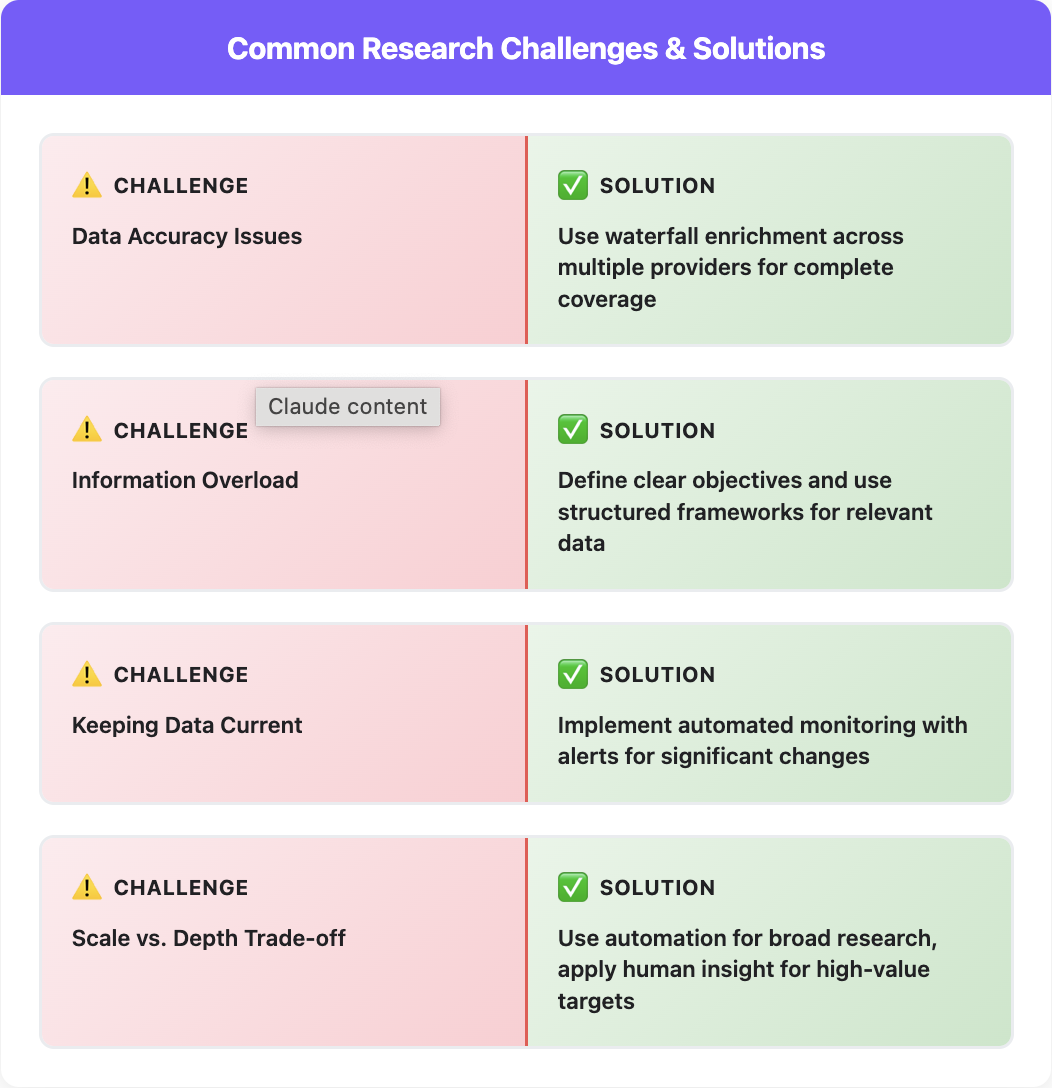How to Research Companies: The Complete Data-Driven Guide for 2025
Modern Company Research: From Hours of Manual Work to Minutes of Automated Insights
Blogby JanJune 09, 2025

Researching companies used to mean hours of jumping between websites, databases, and PDF reports. Today, modern company research combines automated data collection with intelligent analysis to deliver insights in minutes, not hours.
Whether you're qualifying prospects, analyzing competitors, or preparing for an interview, this guide shows you exactly how to research companies effectively using both traditional methods and cutting-edge automation tools.
Why Company Research Matters More Than Ever
Company research forms the backbone of informed business decisions. Sales teams use it to identify high-value prospects. Marketers leverage it to understand target audiences. Job seekers rely on it to find the right cultural fit.
Yet 73% of sales professionals report spending more time on research than actual selling, according to recent industry data. The challenge isn't finding information—it's finding the right information efficiently.
The Cost of Manual Research
Consider this scenario: A sales rep needs to research 50 potential clients. Using traditional methods:
- 15 minutes per company for basic information
- 30 minutes for contact identification
- 10 minutes for data verification
- Total: 45+ hours of research time
With modern company research tools, that same process takes under 2 hours with better data quality.
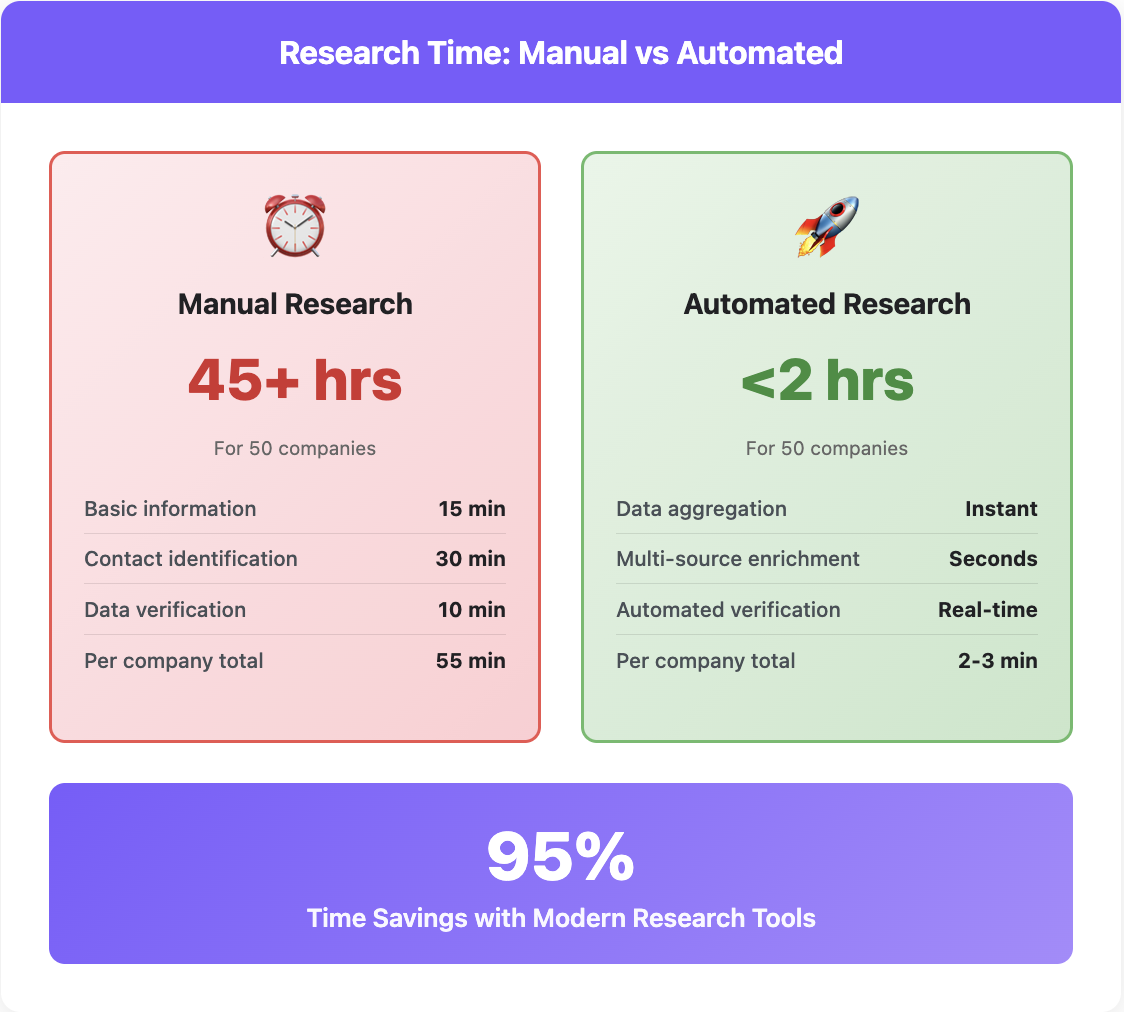
Modern Methods for Company Research
1. Start with Automated Data Collection
Automated company research changes how professionals gather business intelligence. Instead of manually visiting dozens of websites, modern platforms aggregate data from multiple sources simultaneously.
Key data points to collect automatically:
- Firmographic data: Industry classification, employee count, revenue ranges
- Technographic insights: Software stack, technology adoption patterns
- Growth signals: Funding rounds, hiring trends, expansion news
- Contact information: Decision-maker details with verified emails and phone numbers
For example, when researching a fintech company, automated tools can instantly pull:
- Recent funding announcements from Crunchbase
- Technology stack from BuiltWith
- Employee growth trends from LinkedIn
- Executive contact details from multiple databases
2. Leverage Multiple Data Sources Simultaneously
The most comprehensive company research combines multiple data providers rather than relying on a single source. This approach, known as waterfall enrichment, dramatically improves data coverage.
Primary research sources include:
- Company websites: Mission statements, product offerings, press releases
- Regulatory filings: SEC documents for public companies (10-K, 10-Q, 8-K)
- Business databases: Owler, Crunchbase, PitchBook for financial data
- Social platforms: LinkedIn and twitter for employee insights and company updates
- News aggregators: Recent coverage, industry developments
Secondary research sources:
- Industry reports and analyses
- Customer review platforms
- Patent and trademark databases
- Job posting sites for growth indicators
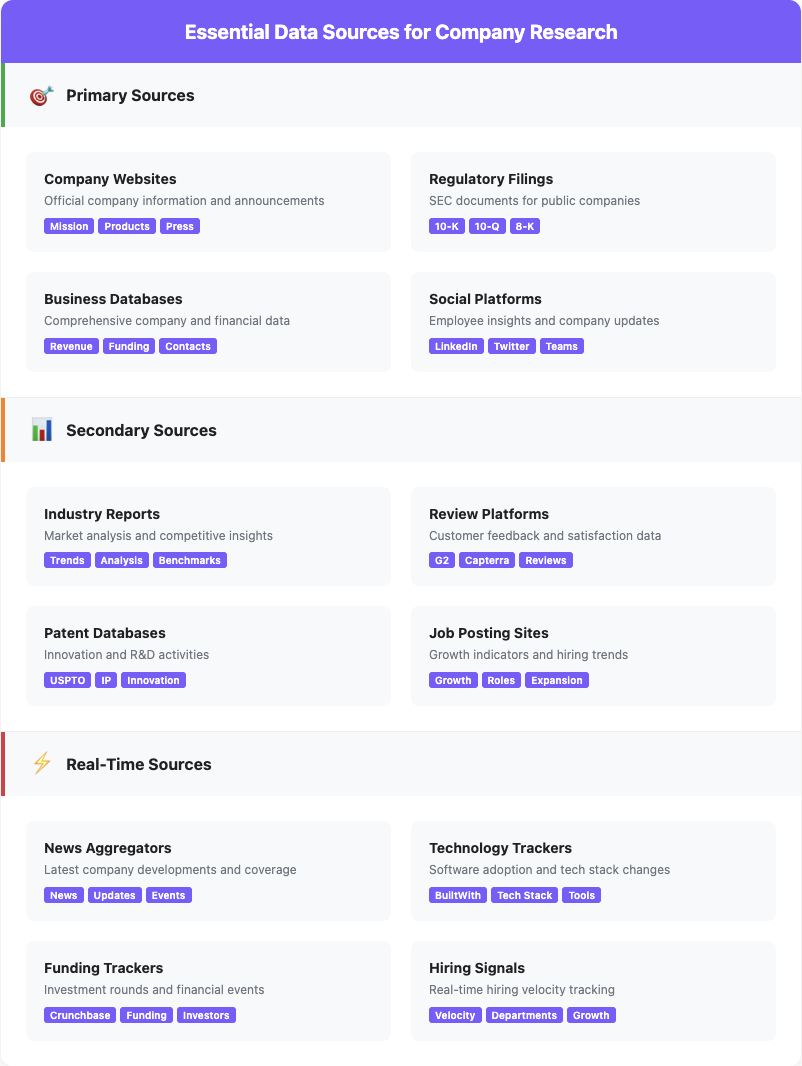
3. Apply Intelligent Filtering and Segmentation
Raw data becomes actionable intelligence through proper filtering. Advanced company research requires precise criteria to identify relevant targets.
Essential filtering criteria:
Geographic filters:
- Headquarters location
- Office presence
- Market coverage
- Time zone considerations
Financial filters:
- Annual revenue ranges
- Funding status and amount
- Profitability indicators
- Growth trajectory
Operational filters:
- Employee count and departments
- Technology usage
- Industry verticals
- Business model type
4. Enrich with Real-Time Data
Static data tells only part of the story. Dynamic company research incorporates real-time signals that indicate business momentum.
Key real-time indicators:
- Hiring velocity: Rapid hiring often signals growth or new initiatives
- Technology changes: New software adoption indicates strategic shifts
- Leadership updates: Executive changes can signal new directions
- Market activity: Product launches, partnerships, acquisitions
For instance, a company posting 10+ engineering roles while adopting new CRM software likely plans significant expansion—valuable intelligence for B2B sales teams.
Company Research for Specific Use Cases
For Sales Prospecting
B2B company research for sales requires identifying not just company fit but also timing and contact accessibility.
Sales-focused research priorities:
- Ideal Customer Profile (ICP) matching
- Does the company fit your target criteria?
- What's their potential deal size?
- Who are the decision-makers?
- Buying signals identification
- Recent funding or budget increases
- Technology stack gaps your solution fills
- Competitive displacement opportunities
- Contact mapping
- Key stakeholder identification
- Reporting structures
- Contact verification and enrichment
For Competitive Insights
Competitive company research reveals market positioning and strategic opportunities.
Competitive analysis framework:
- Market position assessment
- Revenue comparison
- Customer base analysis
- Geographic coverage
- Product and service comparison
- Feature sets
- Pricing strategies
- Customer satisfaction metrics
- Strategic direction indicators
- Hiring patterns by department
- Technology investments
- Partnership announcements
For Job Seekers
Employment-focused company research helps candidates make informed career decisions.
Job seeker research checklist:
- Culture and values alignment
- Mission statement analysis
- Employee reviews and ratings
- Diversity and inclusion metrics
- Financial stability
- Revenue trends
- Funding history
- Market position
- Growth opportunities
- Departmental expansion
- Career development programs
- Internal mobility data
Advanced Research Techniques
Web Scraping for Unique Insights
When standard databases lack specific information, web scraping for company research fills the gaps. Modern AI agents like Databars research agent can extract:
- Office locations from company websites
- Client lists from case studies
- Pricing information from product pages
- Team structure from about pages
Intent Data Analysis
Intent-based company research identifies organizations actively researching solutions like yours. By analyzing:
- Content consumption patterns
- Search behavior
- Technology evaluation signals
You can prioritize companies showing genuine buying intent over those merely in your ICP.
Technographic Profiling
Understanding a company's technology stack reveals:
- Budget availability (enterprise vs. startup tools)
- Technical sophistication
- Integration opportunities
- Replacement possibilities
Technographic research combines website scanning, job posting analysis, and database lookups for comprehensive stack visibility.
Automation in Company Research
Building Research Workflows
Automated research workflows eliminate repetitive tasks while ensuring consistency. A typical workflow might:
- Import target companies from CRM or CSV
- Enrich with firmographic data from multiple sources
- Identify key contacts based on title and department
- Verify contact information through email validation
- Score and prioritize based on fit criteria
- Export to sales tools for immediate action
AI-Powered Analysis
Modern AI company research tools go beyond data collection to provide:
- Automated company summaries
- Competitive positioning analysis
- Personalized outreach suggestions
- Risk assessment and alerts
For example, AI can analyze a company's recent news, financial data, and market position to generate a comprehensive summary highlighting opportunities and risks—work that previously required hours of manual analysis.
Best Practices for Effective Company Research
1. Define Clear Objectives
Before starting research, establish:
- Specific questions to answer
- Decision criteria
- Required data points
- Success metrics
2. Create Research Templates
Standardize your approach with templates for:
- Sales qualification
- Competitive analysis
- Partnership evaluation
- Investment assessment
3. Verify Critical Information
Always cross-reference important data like:
- Financial figures
- Contact details
- Strategic announcements
- Leadership changes
4. Document and Share Findings
Make research actionable by:
- Creating standardized reports
- Updating CRM records
- Sharing insights with teams
- Setting follow-up reminders
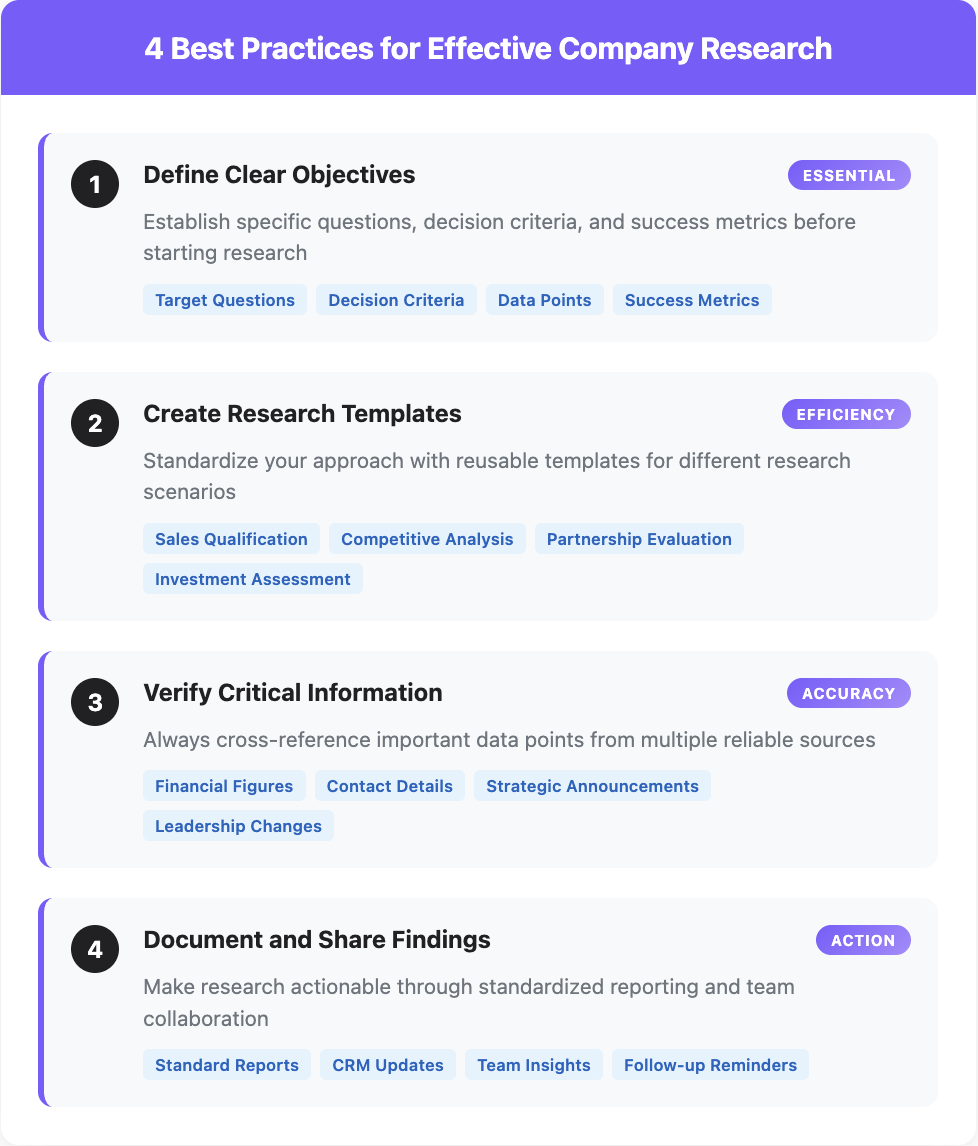
Taking Action on Company Intelligence
Effective company research isn't just about gathering data—it's about turning information into action. Whether you're:
- Building targeted prospect lists
- Analyzing competitive threats
- Evaluating partnership opportunities
- Making career decisions
The combination of in-depth data, intelligent analysis, and efficient workflows makes the difference between good and great outcomes.
Transform Your Company Research with Modern Tools
While manual company research remains valuable for deep analysis, the reality is that modern business moves too fast for traditional methods alone. Today's most successful teams combine human insight with powerful automation to gain competitive advantages.
This is where platforms like Databar.ai revolutionize the research process. By integrating over 90 data providers into a single platform, Databar eliminates the need to juggle multiple subscriptions and tools. Instead of spending hours gathering basic company information, sales and marketing teams can:
- Access firmographic, technographic, and contact data instantly
- Use AI agents to extract unique insights from any website
- Build custom enrichment workflows without coding
- Automate personalized outreach based on real-time company signals
For example, what traditionally takes 45+ hours of manual research for 50 companies can be completed in under 2 hours with higher accuracy and more comprehensive data coverage.
The Competitive Edge of Intelligent Research
Company research has evolved from a time-consuming necessity into a strategic differentiator. Organizations that embrace modern research methods gain:
- Speed advantages: React to market opportunities before competitors
- Data depth: Access insights unavailable through manual research
- Scale capabilities: Research hundreds of companies simultaneously
- Cost efficiency: Reduce research time by 90% or more
The gap between companies using traditional research methods and those leveraging modern tools continues to widen. As data sources multiply and buyer expectations increase, the ability to quickly gather and act on company intelligence becomes increasingly critical.
Whether you're a sales professional qualifying prospects, a marketer understanding target accounts, or a business leader analyzing competitors, mastering modern company research techniques is no longer optional—it's essential for success.
The tools and techniques outlined in this guide provide the foundation for building a scalable, efficient research process. By combining automated data collection with human expertise, you can turn raw information into actionable intelligence that drives real business results.
Ready to scale your company research? Start your free Databar.a trial toaday! The future belongs to those who can gather insights fastest and act on them most effectively.
FAQs
What are the best sources for company research?
The most effective company research combines multiple sources including company websites, business databases (D&B, Owler), social platforms (LinkedIn), and news aggregators. Using a platform that aggregates multiple data providers ensures comprehensive coverage.
How long should company research take?
Basic company research takes 10-15 minutes per company when done manually. However, automated tools can research hundreds of companies simultaneously, reducing time to seconds per company while providing more comprehensive data.
What's the difference between public and private company research?
Public companies must file regulatory documents (10-K, 10-Q, 8-K) providing detailed financial information. Private company research relies more on alternative data sources like news coverage, job postings, and web presence analysis.
What company information is most important for sales?
For sales, prioritize firmographic data (size, industry, location), technographic insights (software usage), growth signals (hiring, funding), and verified contact information for decision-makers. B2B company research should focus on ICP fit and buying readiness indicators.
Related articles
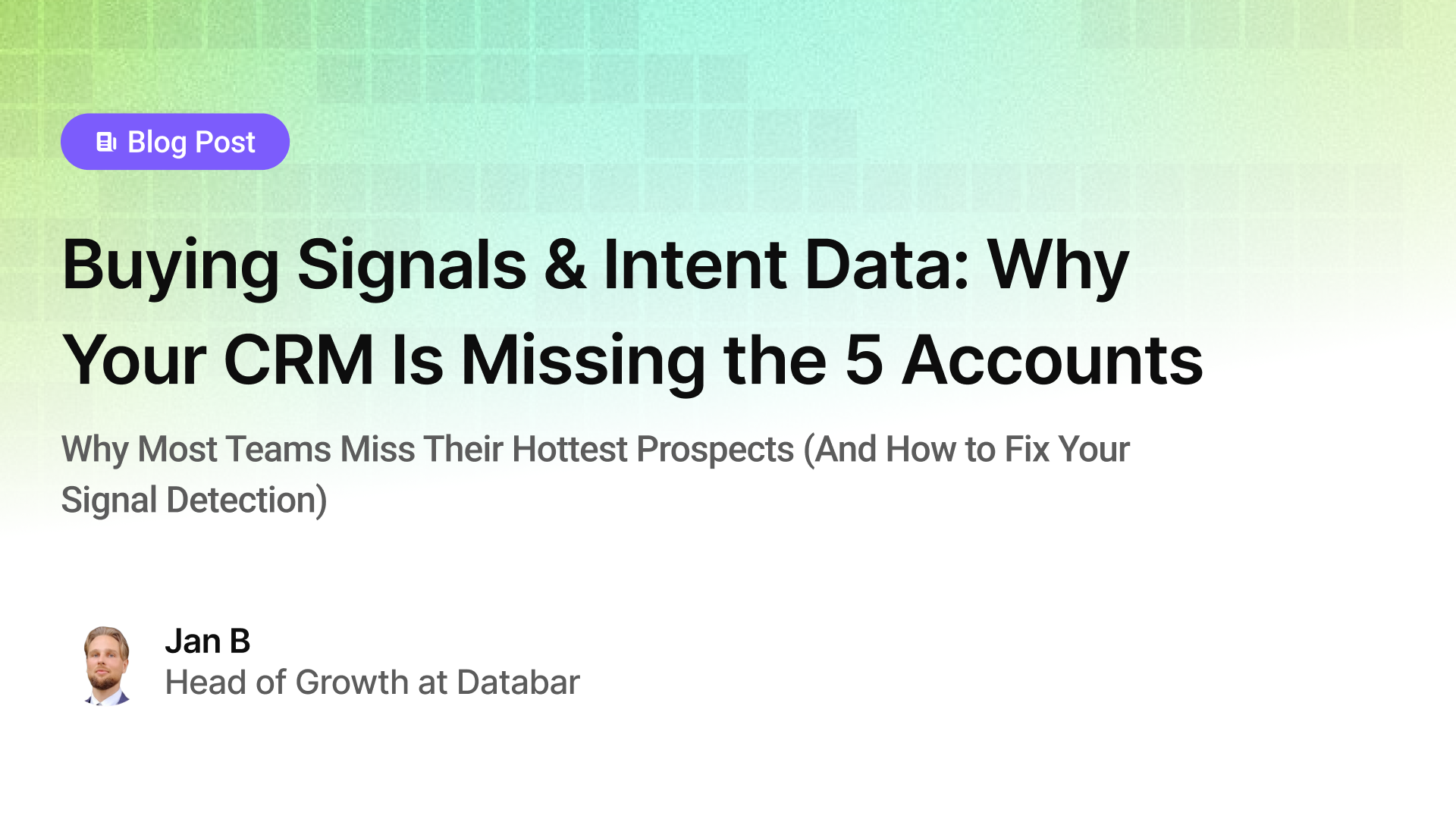
Buying Signals & Intent Data: Why Your CRM Is Missing the 5 Accounts
Why Most Teams Miss Their Hottest Prospects (And How to Fix Your Signal Detection)
by Jan, October 06, 2025

Lead Scoring & Account Segmentation: Why Most CRMs Get This Backward (And How to Fix It)
How to build a system that tells your team who to call, when, and why
by Jan, October 06, 2025
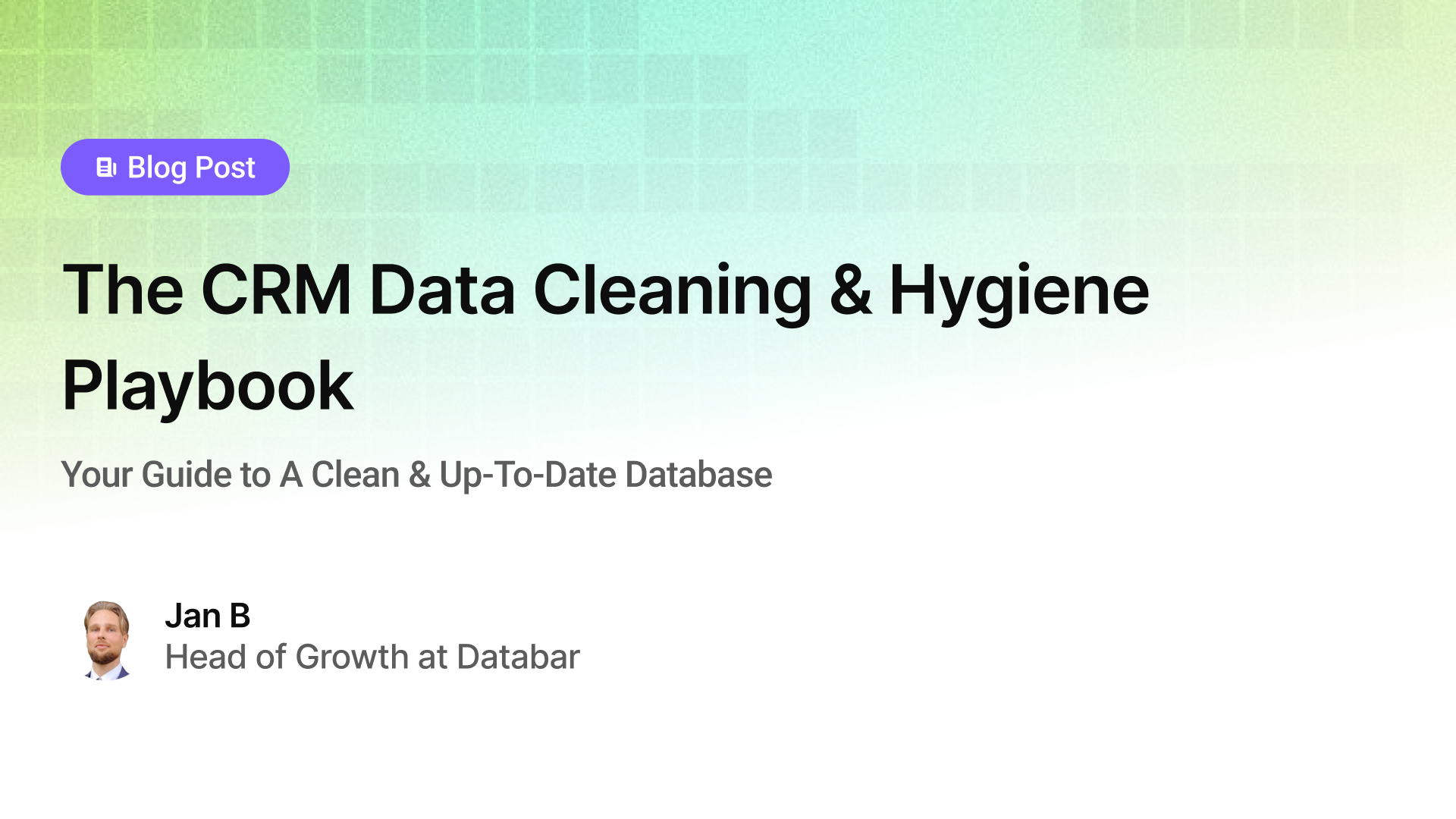
The CRM Data Cleaning & Hygiene Playbook
Your Guide to A Clean & Up-To-Date Database
by Jan, October 04, 2025
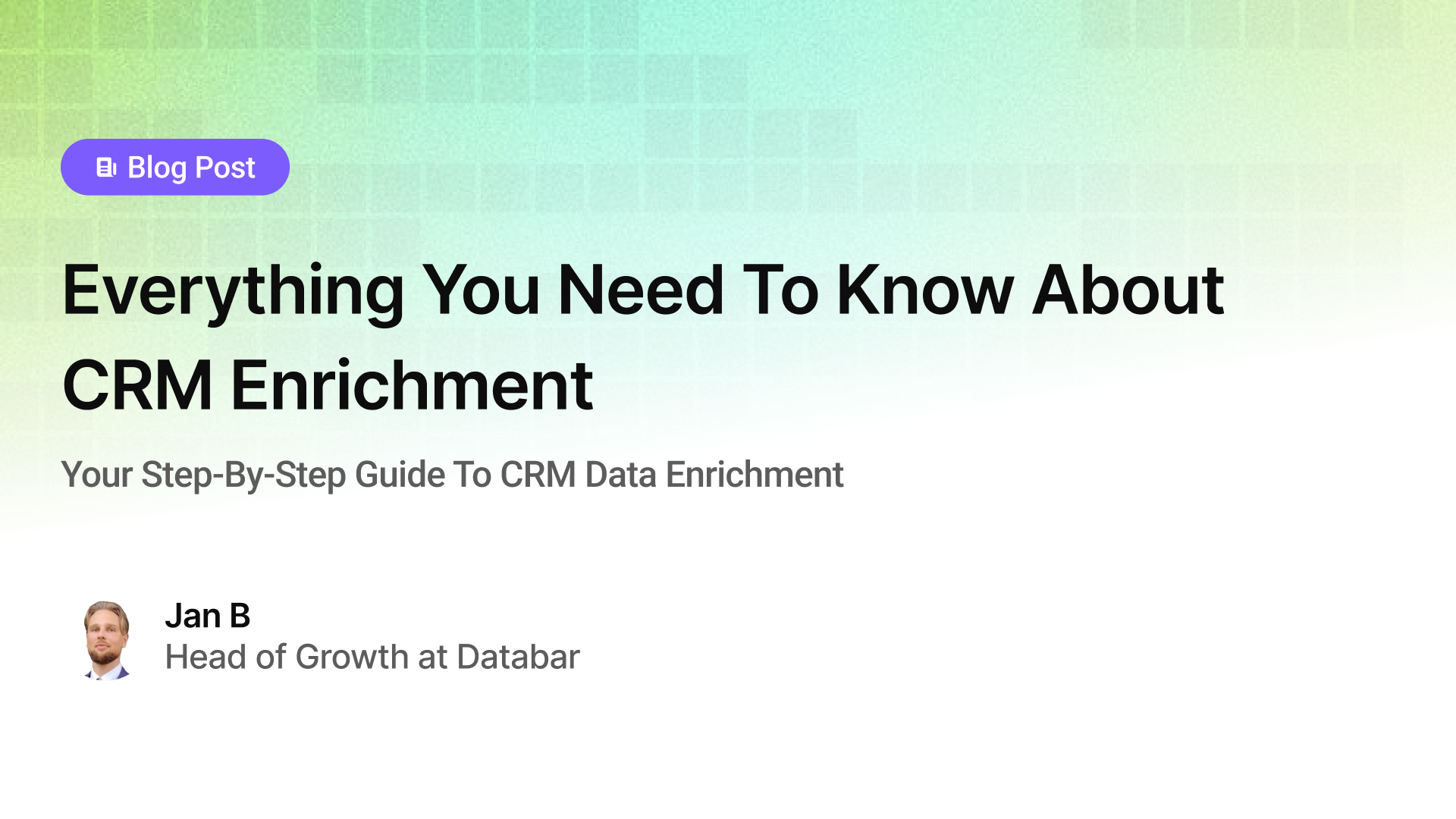
Everything You Need To Know About CRM Enrichment
Your Step-By-Step Guide To CRM Data Enrichment
by Jan, October 03, 2025
